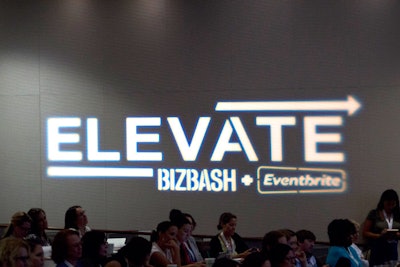
On July 24, the first Elevate conference brought a sold-out audience of event professionals to hear discussions led by social media authority Gary Vaynerchuk; top event designer David Stark; and Univision's vice president of event marketing, Rachel Gross. The gathering at the New York Law School covered topics including understanding new tech trends and the value of social media, analyzing data, producing engaging events and design concepts, and how organizers are adapting to a changing landscape.
Here's a roundup of takeaways from the conference—actionable tips for event and meeting professionals to incorporate into their strategies right now.
1. Tell a story.
Event organizers are storytellers. Vaynerchuk, the morning keynote, argued that it's the job of all event and meeting professionals to tell a story—acting as a media company by serving relevant content and providing value in order to get the attention of the target customer, especially through social media. "Creating good content is the cost of entry into our society right now. If you do not know how to provide value in your communication, you have absolutely no shot of conversion because the world got very noisy," he said. Standing out amongst this din means listening more on social channels and treating the platforms more as a place for two-way conversations than one to promote the latest product, hashtag, event, or cause. Vaynerchuk added, "If you're not understanding the sentiment and authentic feedback given on Facebook or Twitter, you're missing out on so much data of how to make your product and service better."
In the same spirit, smart marketers know how and when to jump into or spark a conversation while remaining relevant. Gemma Craven, executive vice president and New York group director of Social@Ogilvy, gave Oreo as an example. "When the lights went out at the Super Bowl, Oreo very quickly issued a tweet that was a graphic and it really kicked off something we call real-time marketing, which is how brands are creating pieces of content that are then shared on social channels. It's content that's relevant to things happening in large-scale conversations around events."
Similarly, Stark spoke about the idea of all design and decor elements having a meaning directly related to the messaging behind an event. For his projects, establishing what that story is before creating the design concept is key. "It's the difference between decorating the room and making a three-dimensional installation that is about something," Stark said. "My goal is to put meaning into that beauty so that the event is about something, that it has many layers of messaging that people walk away with and think about."
2. Cultivate relationships.
Just as widely agreed upon was the idea of building strong relationships, whether it's with an event's audience, the client and stakeholders, vendors, sponsors, or the internal event team. "We are in the business of connecting experiences, and you cannot do this without creating an army," Gross said. Gross spoke of the importance of empowering a team, understanding how to sell a proposal to an internal client, treating vendors as a member of the family, and always showing gratitude to vendors and partners.
In addition to hosting days for vendors to showcase what's new, Gross said she provides all stakeholders with necessary information, such as the schedule of events during a trade show, the number for booking a car service, contact information for event staff on site, and even relevant Twitter handles and hashtags. "As long as you can share information and eliminate those walls, you'll have a trusting partner, because information is power. If it's the vision in your head, but you don't take the time to explain, you're doing yourself a disservice," she said.
For Event Associates' Debbie Fife and the Robin Hood Foundation's senior vice president of development, Krissy Sudano, creating a personal bond is equally as important in fund-raising. "You're never going to be able to get someone to do more if you're not talking to them. It's all about that personal touch," said Fife. "There's a fatigue factor with email, and the skill of letter-writing and what that can bring is irreplaceable." Sudano added: "We still hand address, we still use live stamps, and we still try and make every envelope—even when we're doing a very large-scale event—as personal as possible."
3. Define the goal first.
One of the first questions Stark asks a client before creating a concept is what the specific goals are. "It's important to look at all the goals so that every choice in the design process is conceived to not only achieve those goals, but surpass them. It's important to build a good foundation from the ground up," he said.
Likewise, Gross stressed the value of defining the purpose of an event or meeting. "Start with the why," she said. "We so quickly rush to the everything else—the vendors, the venues, the marketing. It should be about really defining the why and knowing what you're doing and all of the what and how will fall and fit into place."
4. Focus on the experience, then the results.
"Event organizers are in e-commerce—you aren't selling a good or a service; you're selling an experience," said Tamara Mendelsohn, Eventbrite's vice president of marketing. Other speakers reiterated the point, noting that if you create a great experience, the results will follow.
For Stark, this includes making sure the logistics of an event or meeting are sound. "It's all well and good if the event looks fabulous, but if it's too hot, if there's an hour-long wait at coat check, if the bar runs out of wine, if you wait forever at valet for your car, then your great design is marred by a terrible guest experience. The guests' experience is key and an essential part of the end goal of an event."
5. Understand your limitations.
Also essential is managing the expectations of what an event's budget can bring. "It's everyone's least favorite conversation," Stark said, "but one of the most important ones because I only want to present the right idea that works within the dollars allocated. No one has $100,000 in their back pocket."
Technology can be a time-saver, but it can also malfunction at the most inopportune times. "You have to anticipate the breakdown of technology at your event," said Sudano, sharing examples of lessons she's learned, including assigning more people to oversee technology before and during an event. For Gross, it's also about "knowing when to ask for help and pull in those key people. Don't go it alone."
6. Think on your feet.
"The mark of a good event producer is how well you think on your feet," said Stark when asked about troubleshooting problems. "Don't just sit there and say, 'Woe is me'—make it happen."
Gross shared some recent experiences that she described as "you win some, you lose some. You have to be willing to react smartly, thoughtfully, quickly, and decisively." The key is understanding where something went wrong and how to prevent it in the future. When an unexpected storm forced Robin Hood to postpone a fund-raising concert with the Black Eyed Peas, Sudano and Fife learned the importance of having a channel to clearly communicate with the guests and the event team itself. "We did not anticipate how difficult it is to pull off a concert in Central Park and still raise money," Sudano said.
7. Innovate by looking ahead.
Saya Hillman, the owner of Chicago-based Mac 'n Cheese Productions, spoke about living a "life of yes" and creating opportunities for yourself by positive thinking. "As a kid you fear being the red ball in a room full of green squares," she said. "As an adult, you have to be the ball." The smartest are those who want to stick out from the rest of the crowd and aren't afraid to push themselves.
Stark agreed, saying, "I never want to be an artist that paints the same painting again and again." Additionally, when thinking about events and projects, he adds, "It's not about breaking rules—it's about having no rules"
In terms of social media, Vaynerchuk argued that the key to trends is recognizing current behavior. "People aren't looking at billboards any more—they're not even looking at the road [now that they have smartphones]. They didn't see your banner ad, and they deleted the bulk email promoting your event, and so on," he said. "I implore you to start taking social channels seriously. Instagram got 50 million users in [24 months]. We're grossly underestimating these platforms."



















